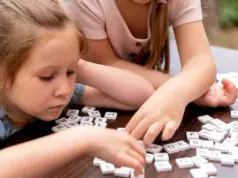
The classroom is a small community where every student has varying abilities, skills, and needs. Therefore, when planning for instruction, we must consider how to support students who are on level, above level, and below grade level. Having a plan in place before you begin instruction will help guide you through teaching students who are behind grade-level reading with effective instructional practices. A lot of these strategies in other forms of comprehension as well, as you can see here.
At the beginning stages of reading, students must learn to read by using phonics and decoding skills. Later, once they have mastered reading fluently, they begin to read to learn, where they’ll rely on comprehension, vocabulary, and background knowledge skills to build meaning. We will break these two categories: strategies to support Learning to Read and students who are Reading to learn. Typically, this divide is around the third-grade level, giving students a Fluency Passage to quickly determine where the students’ decoding ability level is. Remember, even though students are learning to read, they should be taught to make meaning and access new knowledge from the content.
Learning to Read

Locate Specific Gaps in Knowledge
Use a phonics analysis to determine any decoding issues that students may have. At the elementary level of reading, students must decode words and chunk them into syllables to figure out the words.
Teach Phonics and Decoding
Use an approved reading program to help outline a progression of phonics skills to teach your students from where they are. Plan to close gaps twice as fast as they should learn on-grade level skills to help close the gap quickly. Provide students with daily practice of phonics and decoding skills in isolation and in the text on their grade level. See this list of phonics progression as a guide for which phonics skills your students should master at each grade level.
Fluency
Fluency is the rate and expression with which a student reads a passage with “natural” sounding reading. The student should be able to read fluidly without stopping or making errors that inhibit clarity. Build phonics and decoding skills by having the student practice reading the same texts more than once to build automaticity and clear error-free reading.
Support multiple students who are behind grade level by working with a small group and practicing reading theater. Readers theater is a rich strategy where students practice reading a fun play or passage with multiple characters. Students are each assigned a character and must practice reading their lines multiple times to improve fluency. Once they have mastered their lines, they “perform” the piece by reading through their lines fluently.

Making Connections and comprehension
This last step is a building block to bridge the gap to the next level, Reading to Learn. As students interact with text and successfully decode what they are reading, they need to understand what they’ve read. Comprehension questions and graphic organizers are a great way to check-in with students to determine that they can make sense of what they’ve read. Use your state standards at the grade level in which they are reading to craft appropriate comprehension questions.
Another effective strategy to make sense of reading is to teach students to make connections with what they are reading. Students can make text-to-self, text-to-world, and text-to-text connections as a start. Text-to-self is a personal connection to something in their life or experiences. For example, when reading about Service Dogs, they may connect that their family dog helps to protect them too. Text-to-World is a broader connection to the way in which the world works. For example, a text about habitat conservation might lead to a connection to their background knowledge of the effects of habitat loss. Lastly, text-to-text connections are a powerful connection to relate the information they’ve learned from one book to the new knowledge they are learning in the current book.
Reading to Learn

Build Background Knowledge
Studies have shown that one of the most critical aspects of student literacy is rich background knowledge. Struggling students often have limited background knowledge in science, social studies, and other subjects that prohibit their access to new knowledge. Learners must be able to connect new knowledge to previous knowledge to bridge strong connections and deepen their learning.
Thematic Units are a great strategy to help build background knowledge about various targeted topics. First, work with your team to determine some essential areas of background knowledge that are essential for your students to know. Then, create a unit plan to expose the students to the topic with a variety of media- this can include videos and discussions, photographs and captions, virtual field trips, Nearpod and related articles. Repeated exposure to a topic is the best way to build a students’ connections and background knowledge about the topic.
Build Vocabulary
A vast academic vocabulary is a vital component in moving students from struggling to proficient readers. Teaching vocabulary in context is key. Use thematic units to help focus vocabulary to topic-specific instruction. Students connect new vocabulary better when they have repeated exposure and connected meaning pathways.
Grade-level Tiered Vocabulary helps indicate words that are frequently used at a specific grade level. These words can be explicitly taught, as knowledge of these words builds student proficiency with reading grade-level context.

Knowledge Connections
Like the strategy presented in the learning-to-read section, you’ll want to continue developing connections between prior knowledge and new knowledge. Prompt students with open-ended connection questions as they read. Questions like “What does this remind you of” or “How does this connect to something you already know about the topic” are great ways to prompt connection discussions. You can also explicitly teach students the three types of connections and direct students to make a text-to-text, text-to-self, or text-to-world connection while reading. Finally, continue building comprehension using comprehension questions that are guided by your standards.
As you plan for struggling readers, be sure to build in targeted intervention time that allows you to focus on these strategies and meet with struggling readers at least three times a week to effectively close gaps and catch students up to become on-level readers.









